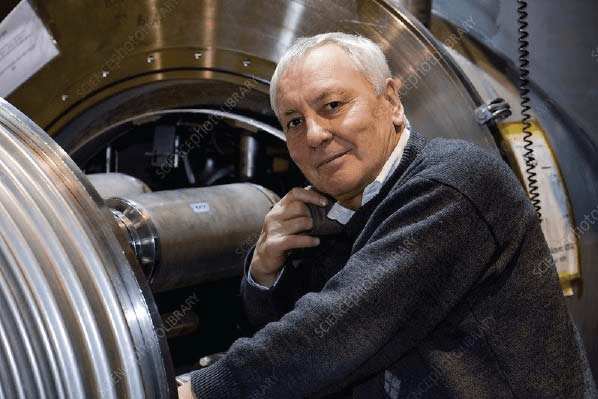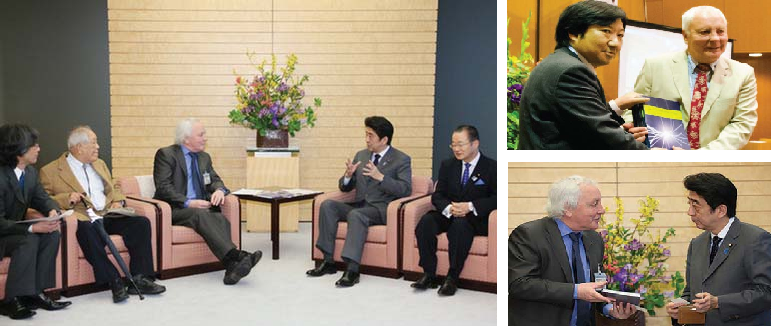International Linear Collider An Interview with Dr. Lyn Evans
- 07 Jan 2019
- Volume 15
- NanoScientific Magazine, Winter 2019

Lyn Evans, CERN physicist. Lyn Evans (born 1945) is a Welsh physicist who became one of the leaders of the Large Hadron Collider (LHC) particle accelerator at CERN, the European particle physics laboratory. At left is part of the ring in which particles are accelerated to near the speed of light and then collided in detectors. Experiments carried out at the LHC intended to discover the Higgs boson led to the announcement of the discovery of a Higgs-like particle in 2012. Evans and other CERN physicists have received awards in recognition of this work, including the Fundamental Physics Prize in 2012. Photographed in 2008.
AN INTERVIEW WITH LYN EVANS, WHO LED THE PROJECT TO BUILD CERN AND IS NOW THE DIRECTOR OF THE INTERNATIONAL LINEAR COLLIDER COLLABORATION
A new era of discovery in particle physics opened in November 2009 with the start-up of the Large Hadron Collider at CERN in Geneva, Switzerland. Based on experiments and discoveries over the last decades, physicists believe that the Terascale will yield evidence for entirely new forms of matters, and possibly even extra dimensions of space. This new matter includes the Higgs particle, as well
as the possibility of an extended family of elementary ‘superparticles’, the heavier cousins of the particles we already know. Lyn Evans joined CERN at 24 and aft er 40 years with CERN, he is now the Director of Linear Collider Collaboration and on brink of announcing the next generation Higgs Factory, the International Linear Collider Project proposed to be built in Japan as a world-wide collaboration to discover new physics.
“The idea of an International Linear Collider is not a new one,” explains Lyn Evans, who has been a champion of this project for many years. In March, 2013, Lyn Evans paid a courtesy visit to Japan’s Prime Minister Shinzo Abe. The Prime Minister acknowledged the significance of the linear collider project for the whole of humankind. Given that it is an international project, he said he needed to monitor the development closely and would continue to investigate the role of Japan.While physicists agree that The International Linear Collider is essential for the next step in understanding our universe, Japan has been studying the idea for years. Recently, at the ILC technology development symposium held in Tokyo June 25, 2018, Lyn Evans stressed that, “Accelerator technology continued to develop thanks to accelerator research facilities brought online in the US, Europe, and China. This means we are in a good place to develop momentum to get [international] cooperation for the ILC.” Next year, the board of directors at CERN will begin deliberations on the next 5-year strategy for particle physics in Europe, so “this is a very crucial period. The Japanese government must make their intentions clear.”

“The idea of an International Linear Collider is not a new one,” explains Lyn Evans, who has been a champion of this project for many years. In March, 2013, Lyn Evans paid a courtesy visit to Japan’s Prime Minister Shinzo Abe. The Prime Minister acknowledged the significance of the linear collider project for the whole of humankind. Given that it is an international project, he said he needed to monitor the development closely and would continue to investigate the role of Japan. (Photo top right): Kicking things off in Tokyo, in 2013, Linear Collider Board Director Sachio Komamiya hands over the ILC Technical Design Report to Lyn Evans, Linear Collider Collaboration director.
With this deadline approaching, things are speeding up. It is very natural for this accelerator to be cited in Japan. In the 1930’s Japan took an early lead in particle physics and in recent decades they have continued to be important players in experimental physics.
Based on recent exciting news from the Governors Meeting in Japan, Evan’s dream may soon become a reality. “It is a great time for Japan to take a leading role in Linear Collider technology. The whole world will benefit from the data it will produce,” stressed Evans.
Japan Governors Agree to Push for the Realization of the ILC
On October 31st, 2018, the meeting for the governors of Hokkaido and the Tohoku
region was held in Kaminoyama City, Yamagata Prefecture where a resolution was
unanimously passed to push for the realization of the ILC, which is the first time this meeting has passed a resolution solely focused on the ILC The resolution calls for the national government to make their stance clear on investment in the ILC and other international cost-sharing measures as soon as possible. Governor Tasso said, “It’s a crucial time right now, as we have to get the ILC into Europe’s next 5 year plan for particle physics. Those preparations begin in January 2019.” Governor Tasso said, “It’s extremely significant that we passed a resolution solely about the ILC. We will call upon all of the governors and related organizations in Tohoku to encourage the national government to make a decision as quickly as possible.”
What is the International Linear Collider?
The International Linear Collider will give physicists a new cosmic doorway to explore energy regimes beyond the reach of today's accelerators. A proposed electron-positron collider, the ILC will complement the Large Hadron Collider, a proton-proton collider at the European Center for Nuclear Research (CERN) in Geneva, Switzerland, together unlocking some of the deepest mysteries in the universe. With LHC discoveries pointing the way, the ILC – a true precision machine – will provide the missing pieces of the puzzle.
Consisting of two linear accelerators that face each other, the ILC will hurl some 10 billion electrons and their anti-particles, positrons, toward each other at nearly the speed of light. Superconducting accelerator cavities operating at temperatures near absolute zero give the particles more and more energy until they smash in a blazing crossfire at the centre of the machine. Stretching approximately 31 kilometres in length, the beams collide 14,000 times every second at extremely high energies – 500 billion-electron-volts (GeV). Each spectacular collision creates an array of new particles that could answer some of the most fundamental questions of all time. The current baseline design allows for an upgrade to a 50-kilometres, 1 trillionelectron-volt(TeV) machine during the second stage of the project. There are also plans for a staged approach starting with a 250-GeV Higgs factory to study the properties of the particle discovered at the LHC in 2012 and then upgrading to 500 GeV.
This century, while physicists have discovered more than ever before, at the nanoscale, they can still not fully explain the origin of massand can only account for a surprising five percent of the universe. The remaining 95 percent, the mysterious dark matter and dark energy is what the proposed International Linear Collider could explain. Not to exclude the potential of new forms of matter, new forces of nature, new dimensions of spaceand time and even extra dimensions.
